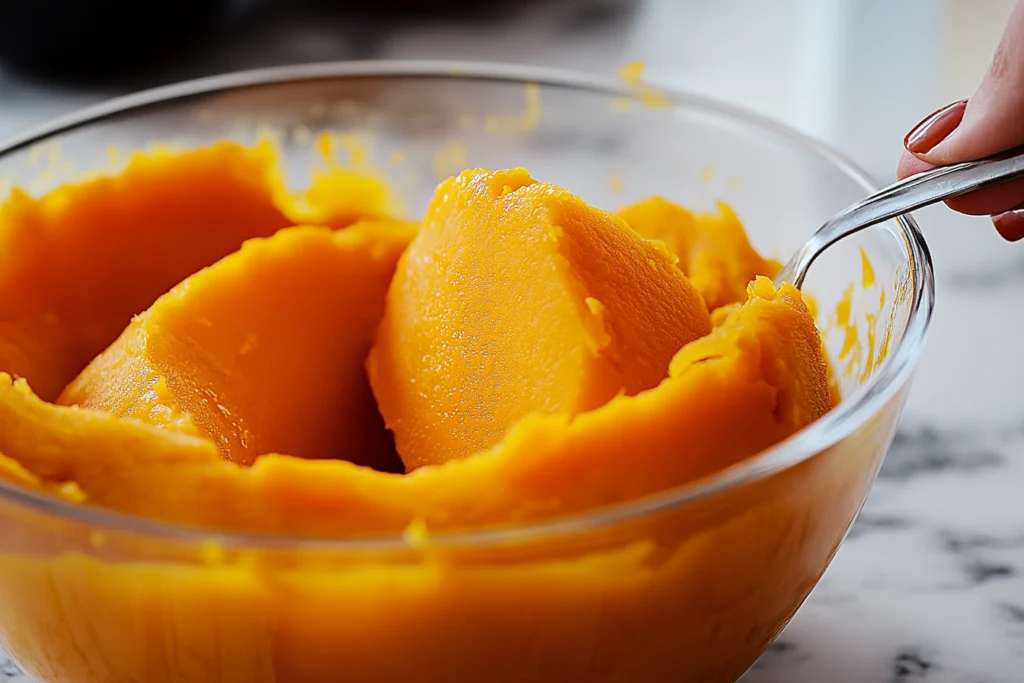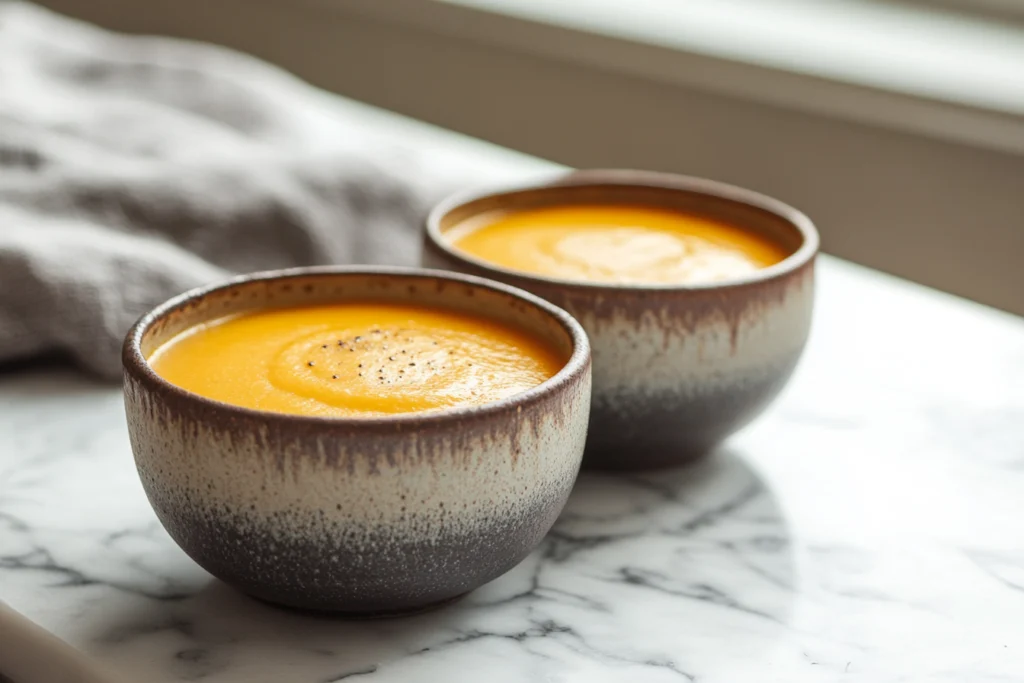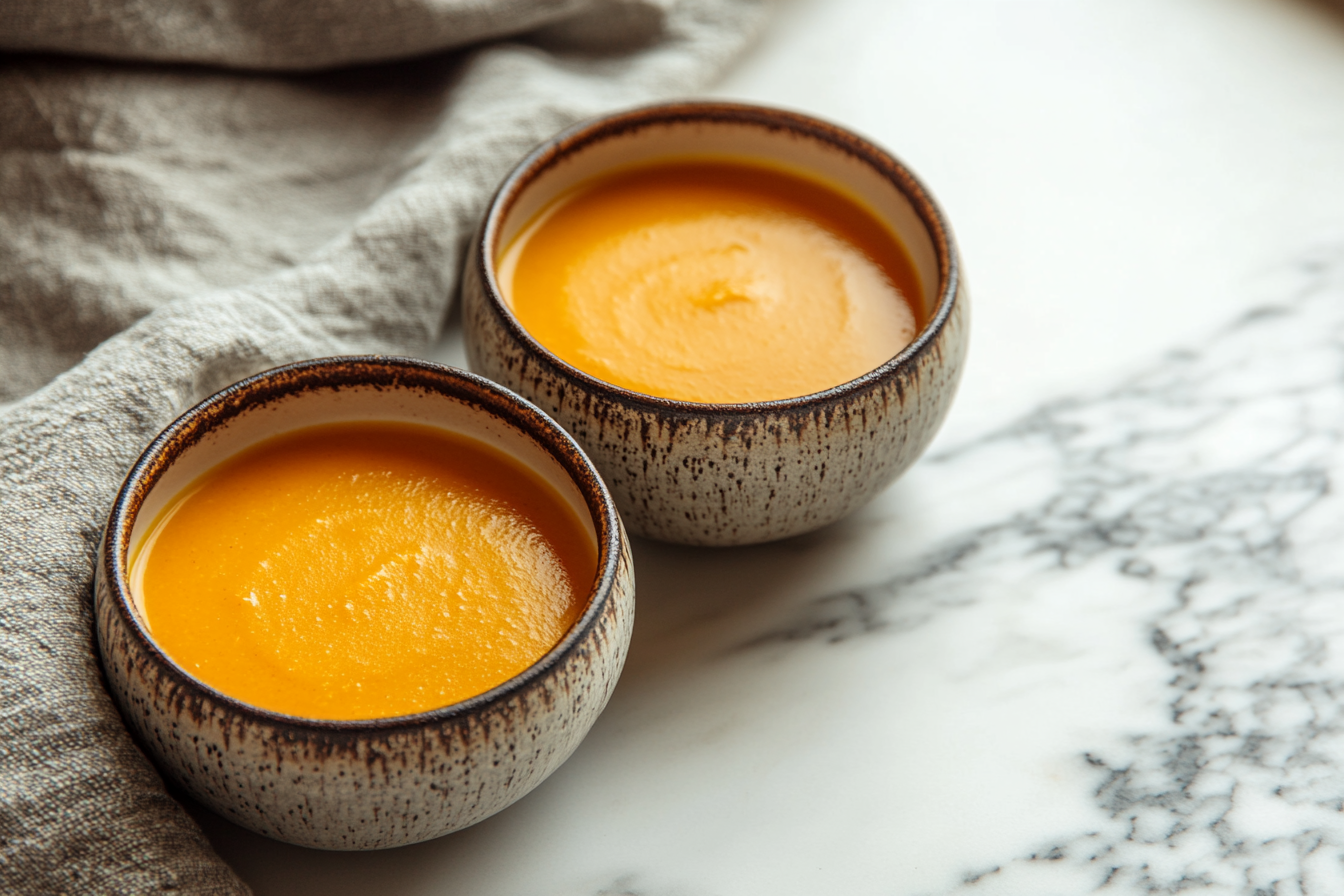Canned pumpkin and pumpkin puree are kitchen staples, especially when autumn rolls around. They’re often used interchangeably in recipes, but they’re not always the same. This article explores their differences, similarities, and how to use them effectively in your cooking. Whether you’re baking pumpkin pies or preparing hearty soups, understanding these products can make all the difference. Let’s dive in!
Introduction and Basics
What is Canned Pumpkin?
Canned pumpkin is a pre-cooked and pureed form of pumpkin that’s preserved in a can. It’s typically made from specific types of pumpkins, such as Dickinson pumpkins, prized for their sweet flavor and smooth texture. Since it’s pre-cooked, canned pumpkin is convenient for busy cooks and ensures consistent quality.
However, not all canned pumpkin is the same. In some cases, it may contain a blend of pumpkin and other squashes, which is perfectly legal under U.S. labeling laws. This blend doesn’t detract from its culinary versatility but can slightly affect the flavor profile depending on the brand you choose.
What is Pumpkin Puree?
It refers to a smoother, more refined version of cooked pumpkin. Unlike canned pumpkin, it can be made fresh at home or purchased pre-made. Homemade pumpkin puree typically involves roasting fresh pumpkins and blending them into a fine consistency.
It’s prized for its natural sweetness and absence of preservatives. Many cooks prefer making their own to control the flavor and texture, though it requires more effort than grabbing a can off the shelf.
Understanding the Basics: Key Ingredients and Uses
While canned pumpkin often contains only pumpkin or a mix of pumpkin and squash, homemade pumpkin puree is typically 100% pumpkin. Both have similar culinary applications, like desserts, soups, and savory dishes, but their textures and flavors differ slightly.
- Canned pumpkin works best for consistent results in baked goods.
- Pumpkin puree shines when a fresher, more natural flavor is desired.
Fun fact: Fresh pumpkin puree often has a brighter orange color than canned pumpkin due to the absence of additives or blending processes.
Differences Between Canned Pumpkin and Pumpkin Puree
How are Canned Pumpkin and Pumpkin Puree Made?
The manufacturing processes for canned pumpkin and pumpkin puree set them apart significantly.
Canned Pumpkin:
Canned pumpkin is created in large-scale facilities where pumpkins (and sometimes squash) are peeled, cooked, and pureed before being vacuum-sealed in cans. This process extends its shelf life and preserves its smooth, thick consistency.
Pumpkin Puree:
Homemade pumpkin puree starts with fresh pumpkins, usually small pie pumpkins, known for their sweetness. The pumpkins are halved, seeded, roasted, and blended into a creamy texture. When made at home, it offers a fresher flavor and no preservatives, making it an excellent choice for clean-eating enthusiasts.
Texture, Consistency, and Flavor Profile
One of the most noticeable differences lies in their texture and flavor.

- Texture and Consistency:
- Canned pumpkin has a denser, more uniform texture, thanks to industrial processing techniques.
- Pumpkin puree is often slightly looser or chunkier, especially if made fresh at home, though this can vary depending on blending time.
- Flavor Profile:
- Canned pumpkin typically has a neutral, slightly sweet taste with a hint of squash-like earthiness.
- Fresh pumpkin puree delivers a richer, more vibrant flavor that feels closer to the original fruit.
Nutritional Differences
Canned pumpkin is sometimes enriched during processing, while homemade puree retains all-natural nutrients from the pumpkin itself.
Canned Pumpkin Nutritional Content (per 100g):
| Nutrient | Amount |
|---|---|
| Calories | 40 kcal |
| Carbohydrates | 9 g |
| Fiber | 3 g |
| Protein | 1.2 g |
| Vitamin A | 245% DV |
Pumpkin Puree Nutritional Content (per 100g):
| Nutrient | Amount |
|---|---|
| Calories | 38 kcal |
| Carbohydrates | 8.5 g |
| Fiber | 3.2 g |
| Protein | 1.4 g |
| Vitamin A | 250% DV |
Culinary Applications and Recipes
Both canned pumpkin and pumpkin puree are versatile ingredients in the kitchen, but knowing where to use each can elevate your dishes.
Canned Pumpkin:
- Best for baked goods like pies, muffins, and breads where consistency is critical.
- Its thick texture ensures it holds up well during cooking, especially in structured recipes.
Puree:
- Perfect for soups, purees, and baby food due to its fresher taste and slightly lighter texture.
- Excellent for savory dishes like risottos or as a base for sauces.
Would you like to learn how to substitute one for the other in your favorite recipes? Let’s move on to the next section!
Choosing Between Canned Pumpkin and Pumpkin Puree
When to Use Canned Pumpkin
Canned pumpkin shines in recipes requiring a consistent texture and predictable results. Its uniformity, dense texture, and long shelf life make it a favorite for baked goods and holiday desserts.
- Baking: The consistency of canned pumpkin ensures that pies, muffins, and breads come out perfectly each time. It holds moisture well, which is critical for achieving tender baked goods.
- Convenience: Canned pumpkin saves time. There’s no peeling, roasting, or blending involved—just open the can, and it’s ready to use.
- Allergy-Friendly Recipes: Thanks to its simplicity and lack of added sugar or spices, canned pumpkin works well in recipes tailored for dietary restrictions.
Examples:
- Classic pumpkin pie
- Moist pumpkin bread
- Spiced pumpkin cookies
When to Use It
If you’re after vibrant, fresh pumpkin flavor and have the time to prepare it, pumpkin puree is your best choice.
- Soups and Sauces: Its natural sweetness and light texture make it perfect for creamy soups or savory sauces.
- Baby Food: Since homemade pumpkin puree is free from additives, it’s an excellent choice for making nutritious, homemade baby food.
- Custom Seasoning: Homemade puree allows you to control the flavor profile of your dishes, tailoring spices and sweetness to suit your needs.
Examples:
- Velvety pumpkin soup
- Fresh pumpkin ravioli filling
- Pumpkin risotto
Substituting Canned Pumpkin for Pumpkin Puree (and Vice Versa)
Can you swap one for the other? Absolutely! However, a few adjustments might be necessary to maintain the desired consistency and flavor in your recipes.
- Using Canned Pumpkin in Place of Pumpkin Puree:
- Reduce the liquid in the recipe slightly, as canned pumpkin is thicker than most homemade purees.
- Add a pinch of sugar if needed to mimic the slightly sweeter taste of fresh puree.
- Using Pumpkin Puree in Place of Canned Pumpkin:
- Strain the puree to remove excess water, especially if it seems too runny.
- Adjust seasoning, as fresh puree might need extra spices to match the flavor intensity of canned pumpkin.
Comparing Store-Bought and Homemade Versions
Store-Bought Canned Pumpkin vs. Homemade Pumpkin Puree
Choosing between store-bought canned pumpkin and homemade pumpkin puree often depends on your priorities—convenience or freshness. Both options have unique advantages, but understanding their differences helps you make informed choices in the kitchen.

Store-Bought Canned Pumpkin:
- Pros:
- Ready to use straight out of the can, saving you time and effort.
- Uniform in texture, flavor, and moisture content, ensuring consistency in recipes.
- Widely available year-round, making it easy to stock up for your favorite dishes.
- Cons:
- May contain a blend of squash and pumpkin, depending on the brand.
- Slightly less vibrant in flavor compared to fresh pumpkin puree.
Homemade Puree:
- Pros:
- Made from fresh pumpkin, offering a rich and natural flavor.
- Free from preservatives or additives, ideal for clean eating.
- Allows you to use specific types of pumpkins for tailored tastes.
- Cons:
- Labor-intensive, requiring roasting, peeling, and blending.
- Shorter shelf life unless frozen properly.
Benefits of Homemade Pumpkin Puree
For those who appreciate the authenticity and freshness of homemade ingredients, pumpkin puree offers several benefits:
- Control Over Ingredients: You know exactly what goes into your puree—100% pumpkin with no additives.
- Enhanced Flavor: Freshly roasted pumpkin offers a sweetness and depth of flavor that’s hard to beat.
- Customizable Texture: Blend to your preferred consistency, whether smooth or slightly chunky.
- Sustainability: Homemade puree reduces packaging waste, especially if you compost the leftover pumpkin skins and seeds.
Step-by-Step Recipe: Homemade Pumpkin Puree
Making it at home is simple, but it does require a bit of time. Here’s a foolproof guide:
Ingredients:
- 1 medium pie pumpkin (about 4–5 pounds)
Instructions:
- Prepare the Pumpkin:
- Preheat your oven to 375°F (190°C).
- Wash the pumpkin thoroughly to remove any dirt or debris.
- Slice the pumpkin in half and scoop out the seeds and stringy fibers using a spoon. Save the seeds for roasting later!
- Roast the Pumpkin:
- Place the pumpkin halves cut-side down on a baking sheet lined with parchment paper.
- Bake for 45–50 minutes or until the flesh is fork-tender.
- Scoop and Blend:
- Allow the pumpkin to cool slightly, then scoop the flesh out of the skin using a spoon.
- Transfer the flesh to a blender or food processor. Blend until smooth, scraping down the sides as needed.
- Strain the Puree (Optional):
- If the puree seems watery, strain it through a fine mesh sieve or cheesecloth to remove excess moisture.
- Store:
- Use immediately or store in an airtight container. Refrigerate for up to 4 days or freeze for up to 3 months.
Nutritional Content (per 100g)
| Nutrient | Amount |
|---|---|
| Calories | 38 kcal |
| Carbohydrates | 8.5 g |
| Fiber | 3.2 g |
| Protein | 1.4 g |
| Vitamin A | 250% DV |
Now that we’ve compared store-bought and homemade options, are you ready to tackle some frequently asked questions?
FAQs
What is the main difference between canned pumpkin and pumpkin puree?
The primary difference is how they’re processed. Canned pumpkin is pre-cooked, pureed pumpkin (sometimes mixed with squash), while pumpkin puree can refer to either store-bought or homemade versions that may vary in texture and flavor.
Can I use canned pumpkin instead of pumpkin puree in recipes?
Yes, you can substitute them in most recipes. However, if the recipe calls for a thinner consistency, you may need to adjust by adding a bit of liquid to canned pumpkin or straining homemade puree.
Is canned pumpkin healthier than homemade pumpkin puree?
Both are nutritious and rich in Vitamin A and fiber, but homemade puree offers the benefit of being completely natural without preservatives. Canned pumpkin, however, is just as healthy and often enriched with nutrients during processing.
Can I freeze homemade pumpkin puree?
Absolutely! Store it in an airtight container or freezer-safe bag for up to three months. Thaw it in the fridge overnight before use.
Why is canned pumpkin not as bright orange as fresh pumpkin puree?
The difference in color is due to the type of pumpkin used and the processing method. Canned pumpkin often contains varieties of squash or Dickinson pumpkins, which have a darker, richer tone than the bright orange of freshly roasted pumpkins.
How do I ensure my homemade pumpkin puree has the same consistency as canned pumpkin?
To achieve the same thick consistency, strain your homemade puree using a fine mesh sieve or cheesecloth to remove excess water. Blend it well to make it smooth and uniform.
Final Thoughts: Which Option is Best for You?
Choosing between canned pumpkin and pumpkin puree ultimately depends on your needs and preferences. Canned pumpkin is unbeatable for its convenience, consistent texture, and year-round availability. On the other hand, homemade pumpkin puree offers a fresher, more natural flavor and the satisfaction of making it from scratch.
Both are versatile and nutritious, so you can’t go wrong with either choice. Whether you’re whipping up a quick pumpkin pie or creating a gourmet pumpkin soup, understanding these differences helps you make the best choice for your kitchen adventures.
Get creative, explore new recipes, and enjoy the endless possibilities these pumpkin products bring to your table!


1 thought on “What is the Difference Between Canned Pumpkin and Pumpkin Puree? A Comprehensive Guide”